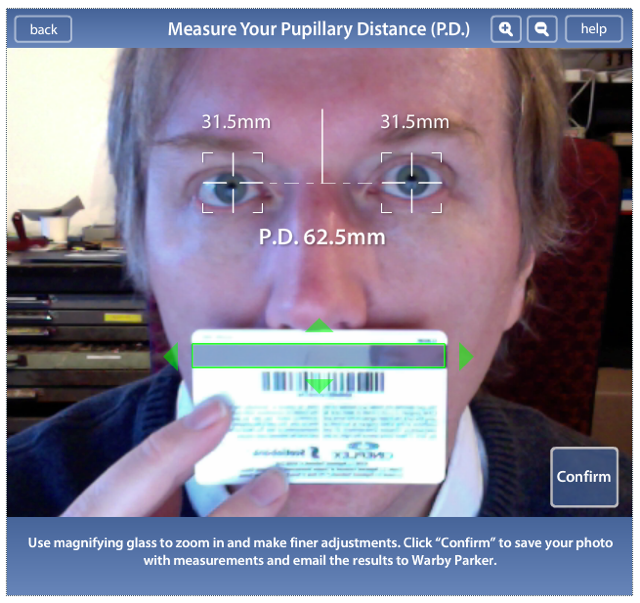Speaking of eyeglasses: when I was in Boston last month, my friend Tom took me to see the Warby Parker shop on Newbury Street. They are a boutique maker of high-fashion, low-cost eyeglasses and have positioned themselves as the “we’re mad as hell and we’re not going to take it any more” competition to the old-line Big Eyeglass cartels. From the team of enthusiastic, fresh-faced young eyeglass zealots that staffed the place, and the crowds milling about, it’s working.
One of the bizarre aspects of the eyecare industry is that the person who tests your eyes and writes you a prescription – despite having all the equipment at the ready – doesn’t tell you what your pupillary distance (distance between your pupils) is; rather it’s part of the “dispensing” that happens where you actually buy your glasses. This makes it a lot harder to mail order for glasses because, well, it’s hard to measure your eyes over the phone.
Or it was. The rise of online eyeglasses retailers has created a need for DIY pupillary distance calculators. Warby Parker has a very slick one that gave me a measurement of 62.5 mm (over 5 tests the range was 62 to 64 mm). They have you hold a credit card up under your nose and use your webcam, which is a smart way of getting an everyday object that most everyone has that has a standard size into the frame to use as a benchmark:

The slightly-less-elegant online tool at FinestGlasses.com calculated the distance at 64 mm (part of the reason it’s less elegant is that you need to measure your glasses to get a baseline, and that’s hard to do if (a) you don’t have a ruler and (b) you can read without your glasses so you can’t see the ruler).
There’s a relatively simply way of calculating your pupillary distance offline that’s outlined here; it suffers, alas, from the problem of needing to measure your glasses so if you can’t see without them you end up with a chicken and egg situation. There’s also the problem of ending up with black Sharpie dots on your glasses ;-)
For the record, recognizing that online eyewear is a thing, the place where I go to get my eyes tested, Charlottetown Vision Centre, will measure your pupillary distance for $69, something they advertise with many “we can’t be held responsible if the cut-rate back alley shop you get your glasses at screws things up”-style language.
 I am
I am
Comments
I tried it and got 62mm too,
I tried it and got 62mm too, but then I looked at the spec on the bridge of my glasses and I see it’s 49-19, which according to another web site means the distance between my two lens centers is 49+19=68mm, not 62mm. The same site says the PD isn’t the be all and end all, though.
I’m guessing the PD is
I’m guessing the PD is critical for grinding and positioning the lenses in the frame, but not so critical to the dimensions of the frame by itself.
The accurate measurement of
The accurate measurement of pupillary distance (space between your pupils or optical centers) is critical in fabricating your prescription eyewear properly. The optical center of the lens should be directly in line with your pupil. The stronger the power of the lenses the more important that it is accurate or vision/eyestrain issues can occur. As a licensed optician who owns two high end optical practices, I have no issues giving my patients their monocular PD so they can order glasses on line. I just advise them that I am not responsible for the result/quality or accuracy of the finished product. My offices fabricate all eyewear on premises and we are extremely accurate in the finished product as well as using lenses only by Carl ZEISS. If you are not familiar with this company look them up!
Add new comment